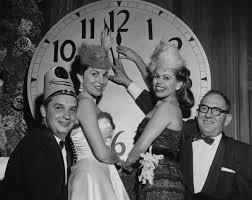
30 Dec New Year’s Eve: History + Art’s Prayer!
Tired of the holidaze by now, from Christmas to Chaunukah to Kwanzaa? Well then, rest assured there is one seasonal event that unites us all regardless of religious (or not) background or ethnicity: New Year’s Eve. About the last Big Event of the holiday trifecta, talk show host and comedian John Oliver recently had this to say: “New Year’s Eve is like the death of a pet. You know it’s going to happen, but somehow you’re never really prepared for how truly awful it is.”
Like it or lump it, who’s to praise (or blame) for New Year’s Eve? This story in Mic Network provides a brief overview.
For a laundry list of reasons that need little more (or endless, ongoing) talk, prayers are in order for this coming year globally, nationally, regionally and locally, so revel in Art Goodtime’s “Prayer for the New Year.”

New Year’s Eve is one of the world’s most celebrated holidays, whether you’re a kid excited to stay up all night or an adult just trying to make it to midnight after a long day of work — or day drinking. But how did the tradition of New Year’s Eve begin — and why do we celebrate it the way we do?
When did New Year’s Eve festivities come about?
The earliest recorded New Year’s celebration is thought to be in Mesopotamia around 2000 B.C., according to Earth Sky. While the celebrations actually occurred during the vernal equinox in mid-March — as this was considered the start of the new year by the calendar at the time — an eleven-day festival was held that would probably put our current parties to shame. According to History.com, the Ancient Mesopotamian people performed rituals, celebrated the religious victory of the sky god Marduk over the sea goddess Tiamat and either crowned a new king or allowed their old king to continue his reign.
Why do we celebrate the new year in January?
The new year wasn’t always celebrated in January, according to History.com, the Ancient Roman calendar used to follow the lunar cycle, and had the new year beginning in March. Sosigenes, an astronomer, convinced Julius Caesar to follow the solar year, instead. From 46 B.C. on, the new year began in January.
Starting the new year in January was partially done to honor the god Janus, for whom the month was named. Since Janus had two faces, he was able to look back into the past and forward into the future simultaneously, making him a great spokesperson for the holiday we celebrate today.
Why do we drop a ball on New Year’s Eve?
Most of us are familiar with the traditional ball drop in New York City’s Times Square; even if we haven’t sojourned to the city to see it, we have likely watched it on TV. But why does New York drop a giant, lit-up ball on New Year’s Eve anyway?
According to PBS, the festivities of New Year’s Eve moved to the New York Times building in 1904 after previously taking place at Trinity Church in Manhattan, where spectators were able to hear the chiming of the bells signaling midnight. However, when the fireworks began, it quickly became obvious that the usual spectacle wouldn’t do: Hot ashes fell down on the streets after the display, causing problems and leading the New York Police Department to put a ban on fireworks.
After this, New York Times publisher Adolph Ochs went to Walter Palmer, the Times’ chief electrician, to create something different to draw in crowds and avoid the rains of fiery doom. Palmer, inspired by the maritime tradition of dropping a time ball so sailors could adjust their chronometers while at sea, devised the idea of dropping a lit-up ball on New Year’s Eve.
The tradition of dropping the ball in Times Square has been a tradition ever since 1907…
Prayer for the New Year

May the light of
our bodies
bless the darkness
Let us not drive
ourselves
into false frenzies
Let us pay
closest attention
to the news at hand
May we walk
through the shadows
into a hot springs like Ouray’s
soaked
in pure light
beneath a cliff’s sheer height
Moon’s curved alabaster
Mountain’s distant
obsidian


Sorry, the comment form is closed at this time.